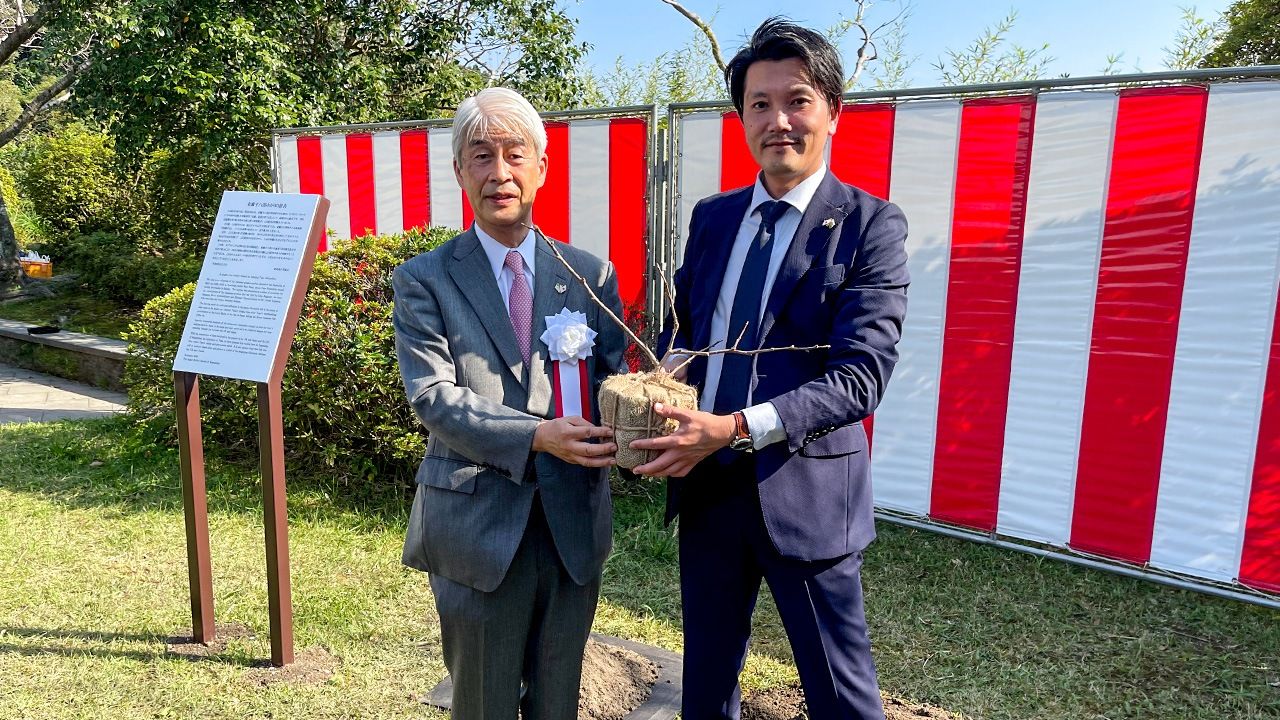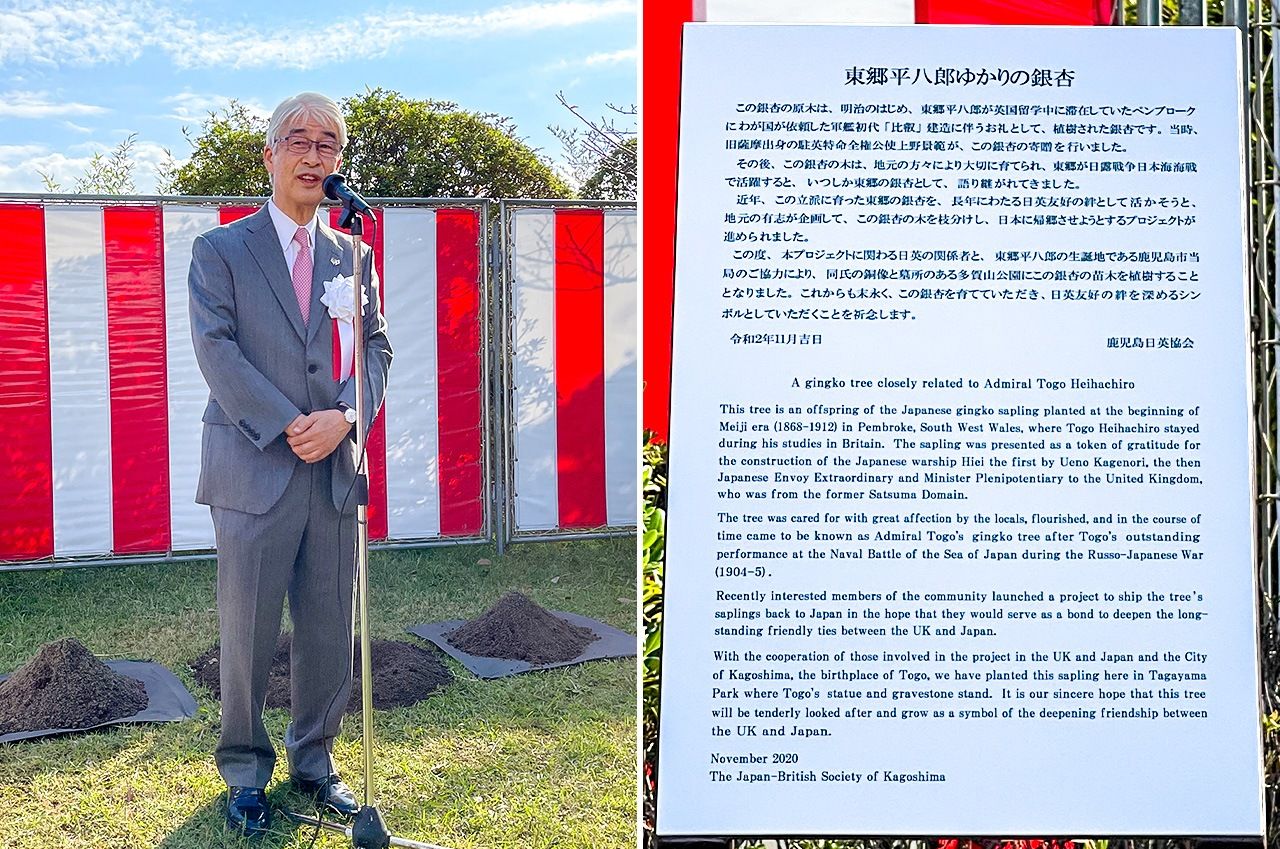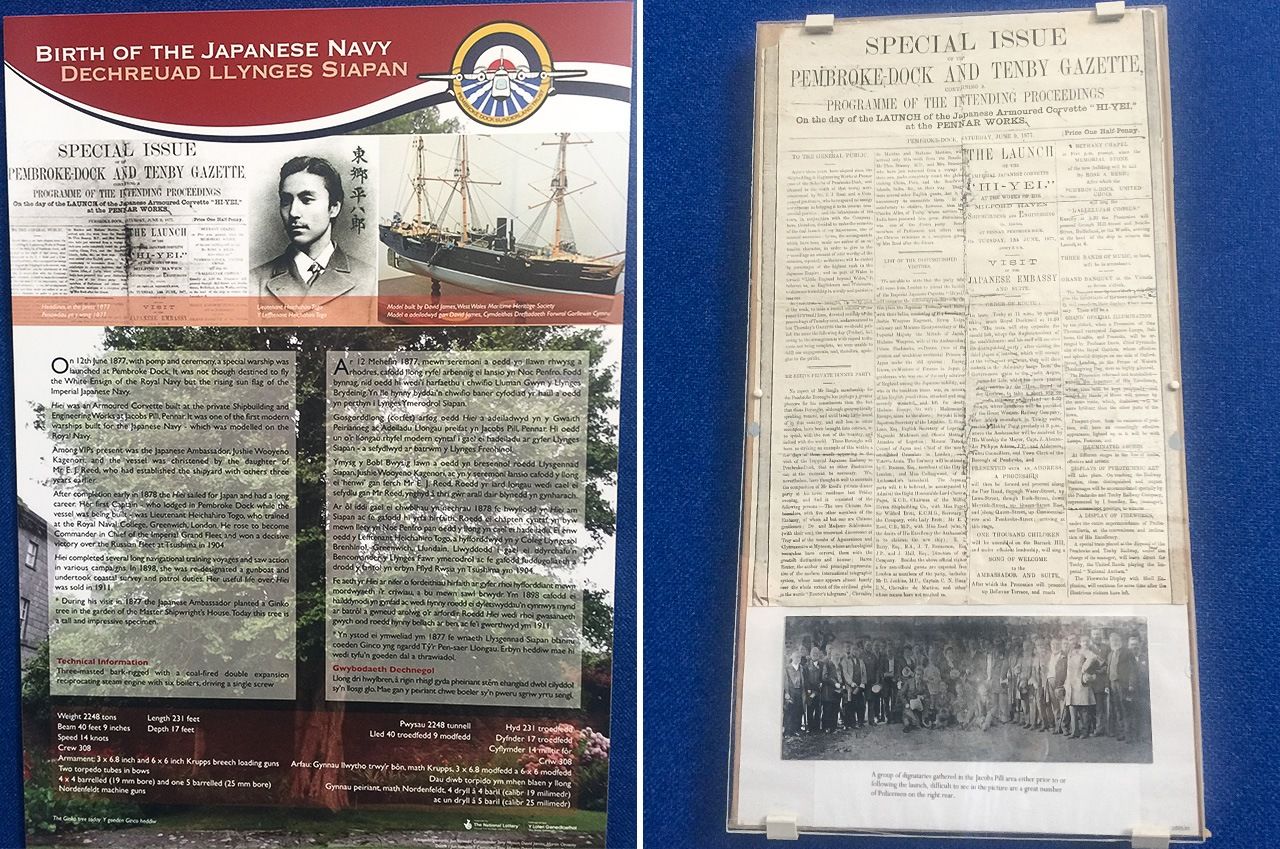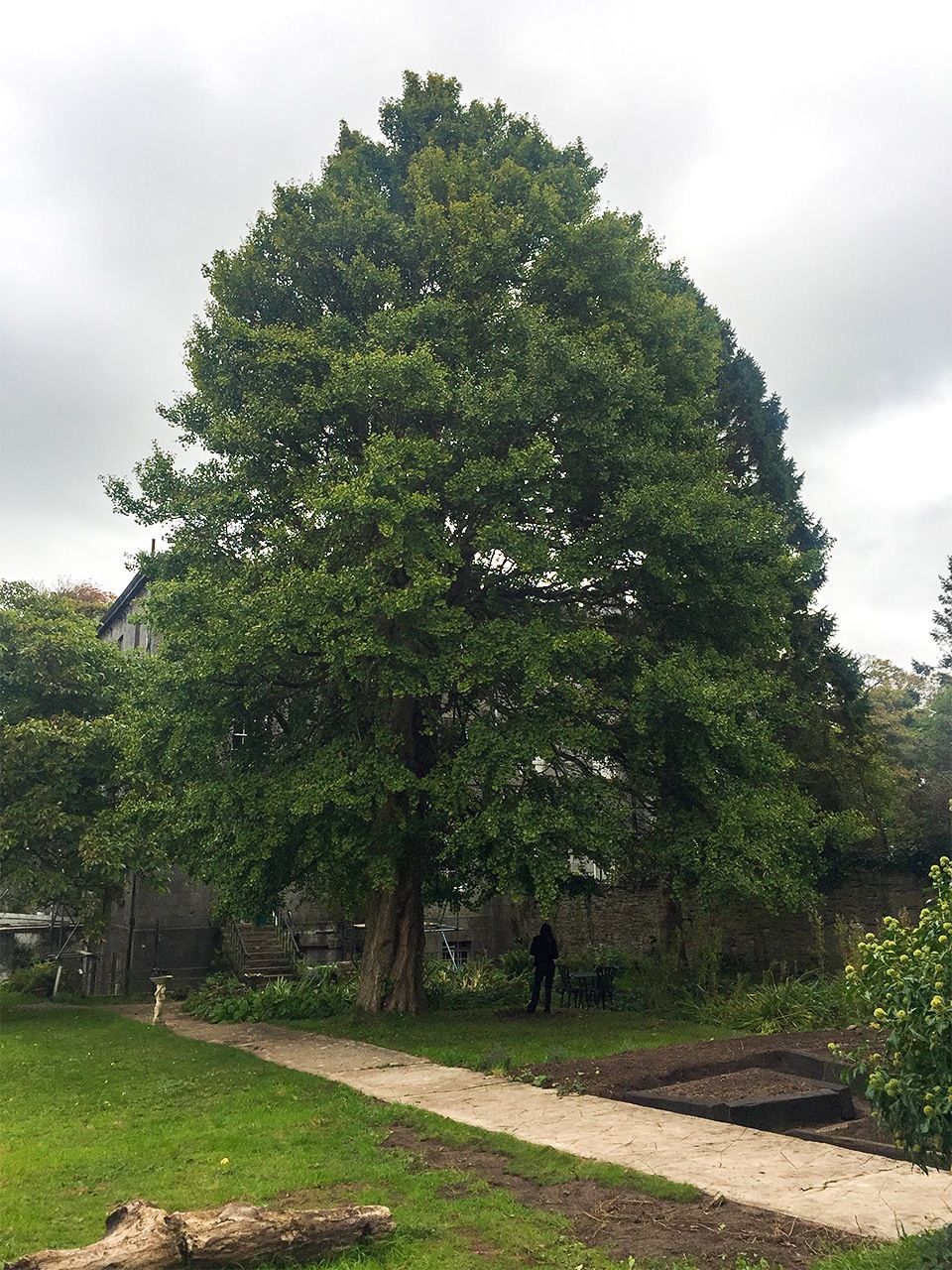
Saplings from Historic Ginkgo Coming Home from Britain
Politics History Global Exchange- English
- 日本語
- 简体字
- 繁體字
- Français
- Español
- العربية
- Русский
Tree Planting Ceremony at Tōgō Memorial
On November 22, 2020, there was a planting ceremony for a sapling grown from Togo’s Ginkgo in Kagoshima City. At the ceremony, the head of the Japan British Society of Kagoshima, Shimazu Kimiyasu, gave a speech describing the donated saplings as deepening historic bonds between Britain and Kagoshima. “This further highlights the connections made by Admiral Tōgō Heihachirō [a native of the Satsuma domain, the original home of the ginkgo] and Japanese Consul Ueno Kagenori during their stay in Britain, and I pray that planting this new tree will help deepen the bonds between Kagoshima and Britain.” Tōgō, admiral of the former Imperial Japanese Navy, was born in what is now the city of Kagoshima, and a sapling from Tōgō’s Ginkgo was planted in a section of Tagayama Park, which also houses a bronze statue of the admiral, and a cemetery where a lock of his hair is buried.

Shimazu Kimiyasu, head of the Japan British Society of Kagoshima, giving a speech at the planting ceremony. At right is a plaque explaining the origin of the Tōgō Ginkgo (Tagayama Park, Kagoshima).
Mori Hiroyuki, then mayor of Kagoshima, also commented on the tree’s significance. “Planting this sapling taken from the Tōgō Ginkgo will strengthen our connection to British communities. The city of Kagoshima is deeply grateful that this symbol of the bonds between Kagoshima and Britain is being placed here in Tagayama Park, where the admiral’s statue stands. We will nurture its growth to inspire our young people carry on the zeal that drove the youth of the Satsuma Domain to study in Britain and help Japan’s efforts at modernization.”
British Ambassador to Japan Paul Madden also sent his congratulations, saying that the ginkgo saplings, raised with such care by the people of Pembroke, represented a relationship between Japan and Britain that was soon to reach new heights.
Arimura Haruko, a member of Japan’s House of Councillors and blood relation to Admiral Tōgō, said she hopes that the trees will serve as proof of the shared histories of Japan and Britain, both island nations with strong maritime traditions, as proponents of freedom and democracy.
A Donation from Japan in Recognition of Warship Mastery
The ginkgo tree is one link in a long line of historical connections between Kagoshima, which was once a feudal domain known as Satsuma, and Britain. The first link, surprisingly, was forged from conflict. The so-called Namamugi Incident of 1862, when a British citizen was killed by bodyguards of a Satsuma samurai, led to military clashes between the two. However, post-hostility peace negotiations resulted in the Satsuma clan sending political delegations, and many young students, to Britain. Their work led to steamships, machinery, and weapons being imported from Britain in the first friendly bilateral relations, which went on to become the foundation of Japan’s alliance with Britain after the Meiji Restoration.
The Meiji government ordered a total of three warships from Britain, the world’s leading shipbuilder at the time. The ships, the Kongō, Hiei, and Fusō, were the only modern armored warships in Asia, and came to symbolize the new Japanese Navy. The Hiei, a corvette, was built at a shipyard in Pembroke, Wales, a city far to the west of London.
At the time, owning such armored warships was likely the modern equivalent of holding nuclear weapons, and so Japan’s government was deeply grateful for the skill that went into their construction. According to a local newspaper, a large group of Japanese delegates, including Kagoshima-born Consul Ueno Kagenori, rushed to the grand launching ceremony in Pembroke in June 1877 by chartering a train from London. Tōgō was also in Pembroke, as he had been studying to become an outfitter there since 1871, and not only did he participate in the launch ceremony, but when the Hiei set sail he returned to Japan with it as a naval lieutenant.
The ginkgo was then donated to the local community as a token of gratitude from the Japanese government at an 1878 ceremony held by Ueno and with special request from Tōgō that it be planted outside the Royal Navy quarters where he had lived during his stay.

A poster featuring the Tōgō Ginkgo and Admiral Tōgō (left), and a commemorative photo and local newspaper report on the launching ceremony of the first Hiei (both in Pembroke).

The stately Tōgō Ginkgo in Pembroke.
Consul Ueno was born in the castle town of Kagoshima, and in the waning years of the Edo period (1603–1867) came to feel that English education would be more important than the popular Dutch studies of the day, so started studying on his own. He would later be recruited by the Meiji Government as a diplomat, and assigned to London. Since Ueno was the highest-ranked member of Japanese society in Britain at the time, he officially presented the ginkgo as a gift from the Meiji government.
Today, the Pembroke Dock Heritage Center museum has a display showing a local news report of the Hiei launch ceremony set against the backdrop of the ginkgo, along with a picture of young Admiral Tōgō with a photo of a model Hiei, all on a poster titled “The Birth of the Japanese Navy.” The display also has a commemorative photo of the launch ceremony published in a local newspaper, depicting several Japanese attendees along with the British, and it points out that one of these might very well have been the young Admiral Tōgō.
15 Saplings Grown from Cuttings
Local Pembroke historian David James started the project to return trees grown from the nearly 20-meter-tall ginkgo to places connected to Tōgō back home in Japan in 2018, with help from retired Japan Air Self-Defense Force Major General Matsui Ken, who now lives in Swansea, Wales. Matsui advised he try trimming some of the tree’s limbs and planting the cuttings to grow into saplings, which could be more easily transported back to Japan. James then turned to the National Botanic Gardens of Wales, where horticulturists volunteered to care for the 15 cuttings and raised them to a height of around 40 centimeters.
When I first reported on this project in October 2018 for the Sankei Shimbun newspaper, requests to host the saplings came in from Tōgō Jinja shrine in Shibuya, Tokyo, as well as Kure, Hiroshima. Then, at the beginning of 2019, requests came from Maizuru, Kyoto; Sasebo, Nagasaki; Yokosuka, Kanagawa; Tōgō’s birthplace of Kagoshima city; and Chiyoda, Tokyo, where remains of his former home still stand.
However, there were some difficulties importing the saplings due to quarantine issues. Noma Toshihide, the defense attaché at the British Embassy in Tokyo, contacted the plant quarantine office through an embassy official attached to the Ministry of Agriculture, Forestry, and Fisheries, and found that as long as there were no pests or diseases found on the plants, they could clear quarantine and receive permission for export from Britain. This smooth processing was achieved thanks in large part to the cooperation of Tsuruoka Kōji, former Japanese ambassador to Britain, who visited Pembroke to observe the ginkgo and showed great support for the project.
After the saplings were successfully brought to Japan, they required further nurturing at a botanical garden. I wrote another column for the Sankei Shimbun about this issue, this time calling out for a botanical garden to volunteer to care for the saplings. Kamigaki Susumu, director of the Culture and Sports Department for Kure, received a response from Hayashi Yoshiyuki, director of the Hiroshima Botanical Garden, saying that he would be willing to help, and the garden took over their care.
Bonds of Good Will
One major issue was securing transport to Japan. James began collecting money for the effort from Japanese companies working in Britain, including the European branch of Nippon Yūsen, a Japanese shipping company. Kubota Keiji, executive vice president and chief operating officer of NYK Group Europe, contacted his parent firm’s head office and received authorization to provide free transport. NYK had also been involved in building a cenotaph to commemorate Japanese sailors lost in the seas off of Pembroke in the late days of World War II, another project led by David James, and their previous work together helped make this new cooperation possible.
With NYK’s aid, the 15 saplings from Tōgō’s Ginkgo were carried safely from the National Botanic Gardens of Wales to the Hiroshima Botanical Garden, and after acclimating to the Japanese soil there the first of the saplings was transplanted to the garden of the old Tōgō family manor in Kure.
Kure Mayor Shinhara Yoshiake said, “The Royal Navy and Kure were connected through Admiral Tōgō, and this is a day that will go down in history for the Kure Naval District.” Simon Staley, the UK defense attaché to Japan and a supporter of the project, made a statement in Japanese saying, “The ginkgo trees that have come from Wales are hearty, and can live for thousands of years. I hope that Japan-UK relations can become as strong as those trees.” Tōgō Jinja has also transplanted on sapling onto its shrine grounds, but plans to hold the official planting ceremony sometime in the spring of 2021, after the COVID-19 pandemic abates.
The successful return of these trees to Japan was only possible through hard work and fundamental good will of local people both in Japan and in Britain. It was truly a group effort. The respect for Tōgō held by both sides, and the desire to deepen Japanese-British ties through the connection he made, may very well have made the impossible possible.
Deepening Cross-Cultural Understanding and Friendship
The Kagoshima sapling was thus planted at a ceremony on November 22, 2020. However, the city was initially resistant to accept a cutting from Tōgō’s Ginkgo, and informed Kure that it would not actively pursue the project. This came about due to concerns over past conflicts with pacifist groups over the treatment of military history in the city. Eventually, a compromise was reached when the Japan British Society of Kagoshima took over as the primary sponsor of the planting and then publicly donated the tree to the city, which will take over the tree’s care and maintenance.
David James made clear his position that he had no intention of beautifying war. Forgetting the senseless loss of those who die in war, he says, only increases the risk that it will happen again. He reiterates that the goal of his project is rather to increase understanding and to deepen friendship across the different cultures of Japan and Britain.
Some regions of Britain developed strong antipathy toward Japan due to the accounts of men who returned after fighting in the Pacific in World War II, particularly those who were taken prisoner. However, in Pembroke the feeling is one of camaraderie born from the Anglo-Japanese alliance that lasted to around 100 years ago. Since no local soldiers were part of the fighting against Japan, local sentiment still views Japan favorably, and respects Tōgō as the “Nelson of the East.”
That reputation stems from 1905, when Admiral Tōgō stood on the deck with his men fighting amid the flying shells to lead his men to victory against the Russian navy in the Battle of Tsushima, much as Admiral Nelson did against the French and Spanish at the Battle of Trafalgar. He is around the world for his honorable military conduct in rescuing enemy soldiers and treating surrendered enemy officers with respect.
Following Kure, 2021 will see saplings planted in Yokosuka in Kanagawa, Maizuru in Kyoto, and Sasebo in Nagasaki. When they are opened to the public, a common plaque created in cooperation between all four former Imperial Navy cities, inscribed with a message describing the trees’ relation to Admiral Tōgō, will be placed near each.
Britain, which has officially left the European Union, has been struggling with stalled negotiations on a trade agreement with the EU, and the COVID-19 pandemic has killed more than 100,000 people there, the highest number in Europe.
If it hopes to return to the Indo-Pacific as “Global Britain,” it must rely heavily on cooperation from Japan. The return of the Tōgō ginkgos will serve as a catalyst to strengthen bonds between both nations at the personal level, as Japan and Britain still work out new alliances in security, trade, and intelligence at the national level.
(Originally published in Japanese. Banner photo: At left, Shimazu Kimiyasu, head of the Japan British Society of Kagoshima, holds a ginkgo sapling with Karidokoro Takahisa, JBSK executive secretary. All photos © Okabe Noburu.)